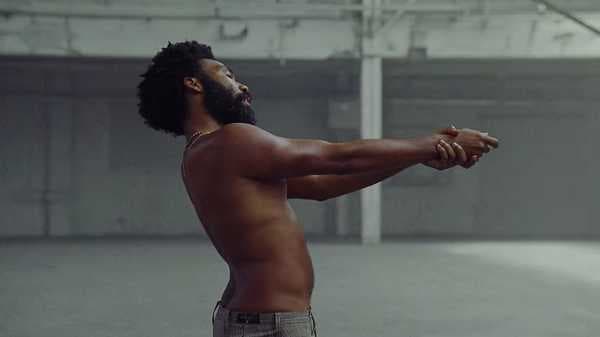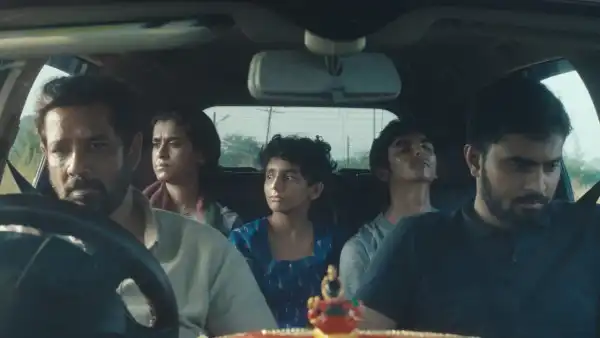
I happened to listen to “This Is America,” the new single by Childish Gambino, a.k.a. Donald Glover, before I saw the eloquent, ultra-violent accompanying video concocted by Glover and the director Hiro Murai. One of the song’s three strands is set to a benign Afrobeat rhythm, with Glover and a backing choir echoing old, edifying dogmas of black striving (“Grandma told me / Get your money, black man”); in another, Glover assumes the tempo of a jazz poet as he declares, “This Is America”; in the third, the familiar voices of Quavo, 21 Savage, and Young Thug are incorporated into the song as ambient reverberations, rather than as discrete guest features. The song, which Glover performed during his hosting gig on “Saturday Night Live” over the weekend, seemed like a portal into a successful black man’s psyche, consumed as it is by guilt and by vanity. I liked it.
The video, which was released online as Glover performed the track on live television, turned the single into a pessimistic statement on American entertainment—both the making and consumption of it. As such, the artist inculpates himself. In the video, Glover is shirtless and his teeth gleam. He plays a kind of deleterious tramp, all instinct, skitting around an airy parking hangar. Dance is its own language; the choreographer for the video, Sherrie Silver, has taught Glover to contort his body in a manner that induces memories of the grotesque theatre of jigging and cake-walking. Sometimes the movements and how they activate his muscles make him look sexy, at other times crazed. His manic elation erupts into violence at a speed that matches something of the media consumer’s daily experience. Glover strikes a pose, and then, in time for the rhythm drop, shoots a black man in the head from behind.
A moment ago, the victim had been strumming a guitar. Glover carefully places the gun on a lush pillow held out for him by an eager school-aged black child. The awful syncopation of murder and music recalls Arthur Jafa’s seven-minute video “Love Is the Message, the Message Is Death,” from 2016, in which footage of a police officer shooting Walter Scott in the back corresponds to a climax in Kanye West’s “Ultra Light Beam.” This is what it’s like, Glover’s video seems to say, to be black in America—at any given time, vulnerable to joy or to destruction. When his character is not dancing, he is killing. The camera amiably follows Glover and a new set of companions, a troupe of uniformed schoolchildren doing the gwara gwara, and then a slew of viral dances. The reprieve ends abruptly when, in another room, Glover is passed another gun, a rifle this time, and murders the members of a black choir. The ten actors fall down in a gruesome heap, reminding us of the night we got word that a young white man had killed a gathering of black worshippers at a church in Charleston. And then Glover is dancing again—this time, with cars burning and police chaos beyond him. The song ends with an eerie melody from Young Thug, who is almost-singing, “You just a big dawg, yeah / I kennelled him in the back yard, yeah.” At the video’s end, Glover is running for his life, the police gaining on him. I’ve been watching it on a loop.
A few years ago, among Glover’s various evolving creative modes (“I’m an actor, writer, and singer,” he said in his “S.N.L.” opening monologue), his career as a musician seemed to be one with a ceiling, and notable for its relative callowness. Childish Gambino was Glover’s imp, born from an online Wu-Tang Clan name generator. His hashtag-rap witticisms, which privileged punch line over narrative, seemed too flimsy to contain a philosophy. Among black people, he became the subject of skepticism: Can you trust the black artist who is so fluent in the tastes of a white society that seems genuinely to love him? Is his suaveness some cover for self-loathing? (“I learn fast—I figured out the algorithm,” Glover told Tad Friend, in a Profile for this magazine, about operating in Hollywood.) With the release of “Awaken, My Love!,” his 2016 funk album, he seemed to deepen, dashing suspicions about his sincerity, and investing fully in a black musical education.
That same year, the FX television series “Atlanta” premièred. With its crystalline fables of ambition and defeat, of the indignities of the social life of black millennials, Glover proved that he possessed an uncanny insight into what it is to be young and black and uncertain. Suddenly, and quite forcefully, Glover was being called the lodestar of a consciousness, the most elegant translator of his generation’s id. Rather than simply accepting the designation and becoming a spokesman, Glover the musician has found ways to point to the absurdity of the celebrity worship that attends his fame. In his new video, he is the executor of carnage and chaos. “This Is America” is currently being analyzed on Twitter as if it were the Rosetta Stone. The video has already been rapturously described as a powerful rally cry against gun violence, a powerful portrait of black-American existentialism, a powerful indictment of a culture that circulates videos of black children dying as easily as it does videos of black children dancing in parking lots. It is those things, but it also a fundamentally ambiguous document. The truth is that this video, and what it suggests about its artist, is very difficult. A lot of black people hate it. Glover forces us to relive public traumas and barely gives us a second to breathe before he forces us to dance. There is an inescapable disdain sewn into the fabric of “This Is America.” The very fact that the dance scenes are already being chopped into fun little GIFs online, divorcing them from the video’s brutality, only serves to prove his point.
Sourse: newyorker.com






